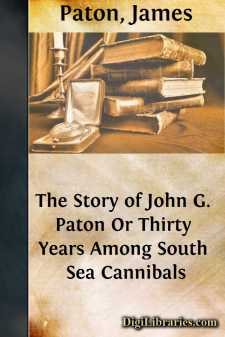Categories
- Antiques & Collectibles 13
- Architecture 36
- Art 48
- Bibles 22
- Biography & Autobiography 813
- Body, Mind & Spirit 142
- Business & Economics 28
- Children's Books 15
- Children's Fiction 12
- Computers 4
- Cooking 94
- Crafts & Hobbies 4
- Drama 346
- Education 46
- Family & Relationships 57
- Fiction 11828
- Games 19
- Gardening 17
- Health & Fitness 34
- History 1377
- House & Home 1
- Humor 147
- Juvenile Fiction 1873
- Juvenile Nonfiction 202
- Language Arts & Disciplines 88
- Law 16
- Literary Collections 686
- Literary Criticism 179
- Mathematics 13
- Medical 41
- Music 40
- Nature 179
- Non-Classifiable 1768
- Performing Arts 7
- Periodicals 1453
- Philosophy 64
- Photography 2
- Poetry 896
- Political Science 203
- Psychology 42
- Reference 154
- Religion 513
- Science 126
- Self-Help 84
- Social Science 81
- Sports & Recreation 34
- Study Aids 3
- Technology & Engineering 59
- Transportation 23
- Travel 463
- True Crime 29
The Story of John G. Paton Or Thirty Years Among South Sea Cannibals
by: James Paton
Categories:
Description:
Excerpt
CHAPTER I.
OUR COTTAGE HOME.
MY early days were all spent in the beautiful county of Dumfries, which Scotch folks call the Queen of the South. There, in a small cottage, on the farm of Braehead, in the parish of Kirkmahoe, I was born on the 24th May, 1824. My father, James Paton, was a stocking manufacturer in a small way; and he and his young wife, Janet Jardine Rogerson, lived on terms of warm personal friendship with the "gentleman farmer," so they gave me his son's name, John Gibson; and the curly-haired child of the cottage was soon able to toddle across to the mansion, and became a great pet of the lady there. On my visit to Scotland in 1884 I drove out to Braehead; but we found no cottage, nor trace of a cottage, and amused ourselves by supposing that we could discover by the rising of the grassy mound, the outline where the foundations once had been!
While yet a mere child, five years or so of age, my parents took me to a new home in the ancient village of Torthorwald, about four and a quarter miles from Dumfries, on the road to Lockerbie. At that time, say 1830, Torthorwald was a busy and thriving village, and comparatively populous, with its cottars and crofters, large farmers and small farmers, weavers and shoemakers, doggers and coopers, blacksmiths and tailors. Fifty-five years later, when I visited the scenes of my youth, the village proper was extinct, except for five thatched cottages where the lingering patriarchs were permitted to die slowly away,—soon they too would be swept into the large farms, and their garden plots plowed over, like sixty or seventy others that had been blotted out!
From the Bank Hill, close above our village, and accessible in a walk of fifteen minutes, a view opens to the eye which, despite several easily understood prejudices of mine that may discount any opinion that I offer, still appears to me well worth seeing amongst all the beauties of Scotland. At your feet lay a thriving village, every cottage sitting in its own plot of garden, and sending up its blue cloud of "peat reek," which never somehow seemed to pollute the blessed air; and after all has been said or sung, a beautifully situated village of healthy and happy homes for God's children is surely the finest feature in every landscape! Looking from the Bank Hill on a summer day, Dumfries with its spires shone so conspicuous that you could have believed it not more than two miles away; the splendid sweeping vale through which Nith rolls to Solway, lay all before the naked eye, beautiful with village spires, mansion houses, and white shining farms; the Galloway hills, gloomy and far-tumbling, bounded the forward view, while to the left rose Criffel, cloud-capped and majestic; then the white sands of Solway, with tides swifter than horsemen; and finally the eye rested joyfully upon the hills of Cumberland, and noticed with glee the blue curling smoke from its villages on the southern Solway shores.
There, amid this wholesome and breezy village life, our dear parents found their home for the long period of forty years....


